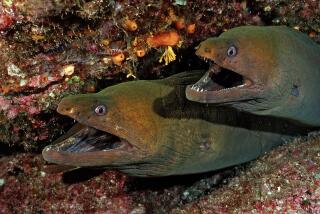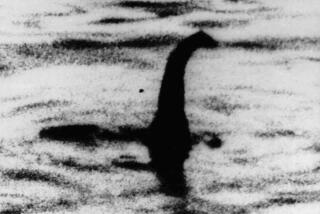A Seal? A Fish? : Sonar Fails to Solve Loch Ness Mystery
LONDON — A 25-boat flotilla combing Scotland’s famous Loch Ness with sonar for signs of the lake’s legendary monster completed its much-publicized three-day search on Sunday after spotting an “unusual” moving object.
Or was it just a seal?
Or a fish?
Indeed, what the organizers labeled the most comprehensive, high-tech search ever undertaken for the Loch Ness Monster provided no immediate answer to the riddle of what, if anything, lurks in one of Europe’s largest, deepest lakes.
The notion that some mysterious being exists in the lake goes back about 1,400 years, when a Christian missionary first talked of “a certain water monster.”
Scientists and Eccentrics
The search for a strange, elusive, creature has generated global interest over the past 50 years, attracting serious scientists as well as eccentrics.
During the first two days of the latest search, organizers reported signals indicating a large moving object, first at a depth of around 180 feet and then again at about 600 feet.
The signals came as the boats, deployed in line across the mile-wide lake, laid down a “sonar curtain” and moved carefully down the lake’s 23-mile length.
But when the leader of the $1.6-million project, Adrian Shine, an amateur British naturalist, emerged to discuss results with an eager gathering of about 200 reporters, he dismissed the notion of a monster.
“Nobody really believed in that anyway, did they?” he asked.
Shine said he believed the object spotted during the sonar sweep was most likely a large fish.
Darrel Lowrance, president of Lowrance Electronics of Tulsa, Okla., which supplied the sonar equipment for the project, looked at the data and made his own pronouncement.
“I tend to think it’s a seal,” he said, implying it may have entered Loch Ness through a a canal that links the lake to the North Sea.
Locals would have none of that.
Affection for ‘Nessie’
They long ago christened their legendary creature “Nessie” and speak of it with an affection worthy of the attention and tourist dollars that it draws to the remote northern districts of Scotland.
“Nessie is like any other wide creature,” commented one resident of Drumnadrochit, a tiny village near the lake. “She’ll hide or run.”
Tony Harmsworth, director of the Loch Ness Center in Drumnadrochit, which draws about 150,000 people each year to an exhibition charting the perennial hunt for Nessie, summed up: “All that has been established, based on scientific data, is that there is something big and moving around in Loch Ness.”
That, coupled with the considerable publicity generated by the search, seemed enough to please those who count the Nessie legend as a key ingredient of their annual income.
More to Read
Sign up for Essential California
The most important California stories and recommendations in your inbox every morning.
You may occasionally receive promotional content from the Los Angeles Times.









